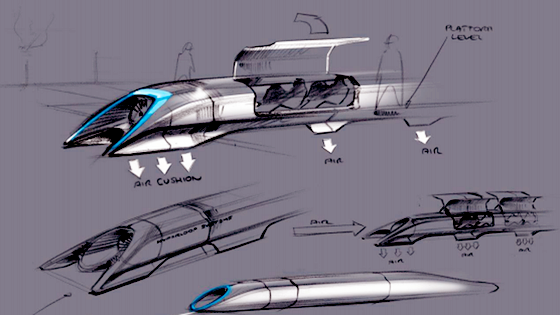Yesterday, ELON MUSK unveiled the HYPERLOOP. Future Travel? ++
This seems too dope to be true. Can the Hyperloop truly be more than the interesting imaginings of a Rich as Fuck and Also Curious Dude and his team of designers? Can it?! I want to zip around at 800 mph, via magnetic levitation.
On Monday, Tesla Motors chief Elon Musk will finally reveal his concept for a high-speed transit system called Hyperloop. The Hyperloop, according to Musk, will be able to whisk you from downtown Los Angeles to downtown San Francisco in roughly the time it takes to watch an episode of Veep. He’s been intentionally vague about details—but that doesn’t mean we can’t make some educated guesses about how he’s going to pull this off.
The plan will be revealed on Monday at 3PM. It’ll be followed by a call at 5PM. Make sure to follow our liveblog of the call right here.
Musk’s inspiration for the Hyperloop was borne out of his distaste for another state-of-the-art transit proposal, a high-speed railroad connecting San Francisco and Los Angeles. That project’s estimated $68 billion price tag would make it the most expensive high-speed line in the world, despite being significantly slower at just a 133 mph clip. To put that in context, the Amtrak Acela line maxes out at 150 mph, while Japan’s “Bullet Trains” can hit up to 20o mph.
If that LA to SF estimate is accurate, Musk’s Hyperloop would average nearly 700 mph, at a tenth of the cost of the existing high speed rail proposal. Or so he claims.
Faster and cheaper is enough to make most people’s ears perk up, but Musk hasn’t provided too many substantive details about how the Hyperloop is supposed to work. Back in May, he described the system as a “cross between a rail gun, the concord, and an air hockey table.” Using this tiny bit of insight and a few other details that he’s divulged, let’s see what we can put together.
What seems certain
Magnetic levitation
There’s a broad consensus that Hyperloop will transport people in magnetically levitated or magnetically propelled pods. This is the same maglev principle used on Japan’s bullet trains, the latest generation of which will average about 300 mph once construction is finally complete.
As we’ll see below, virtually every concept for high-speed transit of this kind—on land, at least—relies on magnetic levitation. To achieve ludicrous speeds in any remotely scalable way, you need to eliminate the friction from tracks. That’s tough to achieve, given that stubborn little bugger called gravity.
By using “tracks” and “train wheels” of opposite magnetic polarity, you can achieve movement without introducing any actual physical contact between container and solid ground. Better yet, magnetic levitation doesn’t just provide a source of lift, it can also serve as the thrust to push a container—or car, whatever—down a line. As a maglev expert told The Verge a while back, the speed you can achieve with maglev is limitless—as long as you’re traveling through a vacuum.




